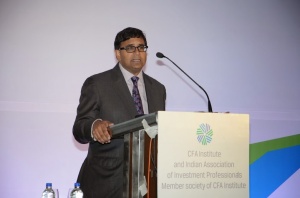- January 24, 2014
- Posted by:
- Category:BLOG, Events, India Investment Conference, Mumbai
Speaker: Avinash Persaud, Chairman at Intelligence Capital and Elara Capital
Moderator: Navneet Munot, CFA, Director IAIP and CIO, SBI Funds Management
Written by: Aditya Jadhav, CFA, Consultant and Jignesh Kamani, CFA, Co-Chair Communications, IAIP and Research Analyst, Nirmal Bang Institutional Equities
Many business journalists think that an asset’s price rises when there is a gush of cash buying it up, but the reality is far different from this. In fact it is a response to good news that market makers are expecting rising future earnings and hence lift their prices until higher prices bring out sellers. When in May 2013, Fed Chairman Bernanke announced that it was to moderate its bond buying program from $85bn to $75bn per month, it triggered a far more dramatic, negative reaction to emerging market currencies, bond markets suggesting that this is the final phase of the stock market rally and it will spark renewed pressure on the rupee.
Persaud is of opinion that asset prices have risen from rising future earnings being discounted to the present by a near zero level of interest rate policy, which started in 2008 post collapse of Lehman Brothers. He also cited that the future of market has little to do with the reversal of Quantitative Easing (QE), as QE has merely played the role of interest rate signal and its taper should be seen as a signal to communicate with the bond markets that the interest rate cycle is reversing. Federal Reserve mere acted as a buyer of last resort in 1st round of QE in 2008, when it started buying bonds from the public to defrost the frozen bond market and till now it has created $5trn out of thin air.
Later rounds of QE were larger, focused on long dated bonds with an expectation that banks would use this cash to buy long term corporate bonds encouraging corporations to finance new investment. Far from wanting to invest their cash in real economy, banks and corporates have been hoarding it. According to the U.S. Federal Reserve Flow of Funds Accounts, non-financial corporate businesses held an unprecedented $1.8trn of liquid assets at the end of 2012 and corporate private investment is still lower than 2008 level. Cash balances have been trapped in a broken system and actual cross border flows were no greater than before. To prove his point Persaud also cited that foreign asset ownership by central bank of countries offering QE is just 17% of emerging market’s assets.
But it doesn’t bring any respite to Indian rupee, as the dollar will enter a cyclical upturn and rupee will come under renewed downward pressure. But the headwinds against rupee may be mitigated if Indian economy rebounds backed by the growth of domestic consumption industry.
– A J and J K
PS: For the video presentation kindly click on http://new.livestream.com/livecfa/Persaud
Each of speaker sessions and the panel discussion has been covered separately under IIC14. These include:
- Corruption of Capitalism: Challenges to Sustainable Growth & Asset Allocations by Richard Duncan
- Future of Finance: Key Issues Facing the Finance Industry by Frederic Lebel, CFA
- A Changing Global Energy Landscape – Implications for India by Dr. Fereidun Fesharaki
- Executive Panel Discussion – India Investment Outlook
- The Inaugural Session by Paul Smith,CFA, Jayesh Gandhi, CFA and Dr.Vikram Kuriyan, CFA
- A comprehensive list of photographs could be viewed in the slide show in the note titled: IIC14-The Road Ahead for India and the Emerging Economies
Kindly check the coverage at http://blogs.cfainstitute.org/investor/2014/01/21/avinash-persaud-were-seeing-the-final-phase-of-the-rally/














[…] · The End of Quantitative Easing, the Outlook for Emerging Markets and the Rupee by Prof. Avinash Persaud. Kindly follow the link http://iaip.wordpress.com/2014/01/24/iic14-the-end-of-quantitative-easing-the-outlook-for-emerging-e… […]